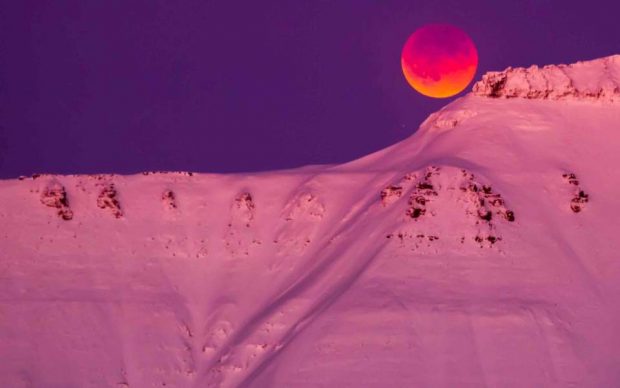Μοναδικά στιγμιότυπα από την ολική έκλειψη της «Ματωμένης Σελήνης» που καθήλωσε τον πλανήτη
1 Φεβρουαρίου 2018
Μια ιδιαίτερα σπάνια ολική έκλειψη Σελήνης προσέφερε ένα εντυπωσιακό θέαμα που ήταν ορατό από διάφορες χώρες του κόσμου οι πολίτες των οποίων απόλαυσαν το εκπληκτικό αυτό φαινόμενο.
Ουσιαστικά όμως δεν πρόκειται για ένα φαινόμενο αλλά για τρία φαινόμενα που σχεδόν συνέπεσαν. Η πανσέληνος, το κοντινό πλησίασμα του δορυφόρου μας στη Γη και η ολική έκλειψη της Σελήνης.
Χιλιάδες άνθρωποι συγκεντρώθηκαν στην Καλιφόρνια για να δουν τη Σελήνη να χάνεται, κρυμμένη από τη σκιά της Γης και μετά να επανεμφανίζεται κατακόκκινη, εξ ου και η ονομασία «ματωμένο φεγγάρι».
Η κόκκινη ή χάλκινη απόχρωση είναι ένα φυσικό φαινόμενο που οφείλεται στο φιλτράρισμα του ηλιακού φωτός από τη γήινη ατμόσφαιρα.
Ο μη επιστημονικός όρος «υπερ-Σελήνη» ή «σούπερ-Σελήνη» είναι δημιούργημα του αστρολόγου Ρίτσαρντ Νόλαν από το 1979.
Ορισμένοι περίμεναν ακόμη και πέντε ώρες ελπίζοντας ότι θα βρουν μια καλή θέση στο αστεροσκοπείο Γκρίφιθ του Λος Αντζελες που άνοιξε τις πόρτες του στις 3:30 τα ξημερώματα για να υποδεχτεί περίπου 2.000 επισκέπτες.
Η έκλειψη ξεκίνησε περίπου 15 λεπτά αργότερα, καθώς μια μαύρη σκιά άρχισε να καλύπτει τη λευκή υπέρ-Σελήνη.
Μια ώρα μετά, το φεγγάρι χάθηκε τελείως κι όταν επανεμφανίστηκε η επιφάνειά του είχε πάρει το χρώμα του χαλκού. Η έκλειψη διήρκησε περίπου τρεισήμισι ώρες.
Το μοναδικό αυτό υπερθέαμα δημιουργείται όταν η Σελήνη βρίσκεται στη μικρότερη απόσταση από τη Γη.
Επειδή η τροχιά της Σελήνης δεν είναι τέλειος κύκλος γύρω από τη Γη, η απόσταση ανάμεσα στο κέντρο του φεγγαριού και στο κέντρο της Γης αυξομειώνεται από τα περίπου 363.400 χιλιόμετρα (περίγειο) έως τα 405.550 χιλιόμετρα (απόγειο).
Έτσι, σε μια πανσέληνο που θα συμβεί στο περίγειο (υπερ-Σελήνη), το φεγγάρι φαίνεται περίπου 14% μεγαλύτερο και 30% φωτεινότερο από μια πανσέληνο που θα συμβεί στο απόγειο.
Το σπάνιο θέαμα ήταν ορατό από τη Βόρεια Αμερική, τη Ρωσία, την Ασία και τον Ειρηνικό Ωκεανό.
Στη Βόρεια Αμερική, την Αλάσκα και τη Χαβάη κάτοικοι και επισκέπτες είδαν την έκλειψη λίγες ώρες πριν ξημερώσει.
Στη Μέση Ανατολή, την Ασία, την ανατολική Ρωσία, την Αυστραλία και τη Νέα Ζηλανδία, το φεγγάρι είχε μόλις ανατείλει.
Το μεγαλύτερο μέρος της Ευρώπης, της Αφρικής και της Νότιας Αμερικής στερήθηκε αυτό το «σόου», αφού τη στιγμή της έκλειψης το φεγγάρι δεν είχε ανατείλει ακόμη σε αυτές τις περιοχές, ήταν ακόμη ημέρα.
Το εντυπωσιακό και μοναδικό φαινόμενο της Σούπερ – Μπλε – Ματωμένης – Σελήνης εμφανίζεται για δεύτερη φορά μέσα σε ένα μήνα, καθώς είχε προηγηθεί αυτή της Πρωτοχρονιάς.
Μάλιστα, επειδή ο Ιανουάριος έχει δύο πανσελήνους, ο Φεβρουάριος δεν θα έχει καμία, κάτι που έχει να συμβεί από το 1999.
Η προηγούμενη «ματωμένη υπερ-Σελήνη» είχε συμβεί στις 30 Δεκεμβρίου 1982 και ήταν ορατή τότε στην Ευρώπη, την Αφρική και τη δυτική Ασία. Η επόμενη θα γίνει στις 31 Ιανουαρίου 2037.
Στην Ελλάδα η έκλειψη έφθασε στο αποκορύφωμά της, δηλαδή η Σελήνη βρέθηκε στο σημείο πιο κοντά στο κέντρο της σκιάς της Γης, περίπου στις 15:30, όταν το φεγγάρι ήταν ακόμη κάτω από τη γραμμή του ορίζοντα, καθώς θα ανέτειλε λίγο πριν από τις 18:00. Αυτό είχε ως συνέπεια το φαινόμενο να μην είναι άμεσα ορατό στη χώρα μας.
Δείτε εικόνες από όλο τον κόσμο που «μαγεύτηκε» από τη δύναμη του σύμπαντος.
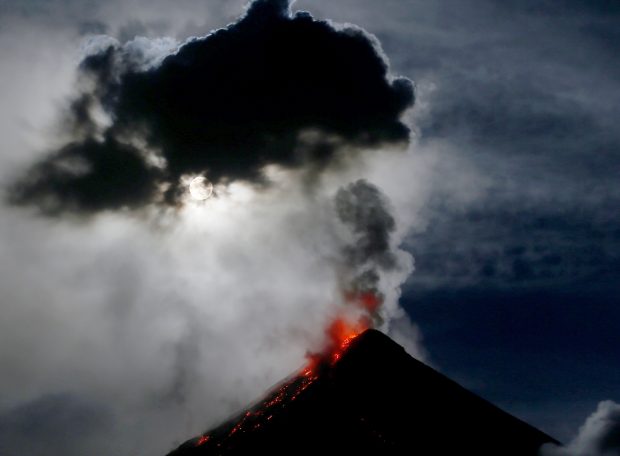
The super blue blood moon, seen through volcanic ash cloud, sets before dawn as lava cascades down the slopes of Mayon volcano during a sporadic mild eruption as seen from Sto. Domingo township, Albay province around 340 kilometers (200 miles) southeast of Manila, Philippines Thursday, Feb. 1, 2018. It’s the first time in 35 years a blue moon has synced up with a supermoon and a total lunar eclipse, or blood moon because of its red hue. (AP Photo/Bullit Marquez)
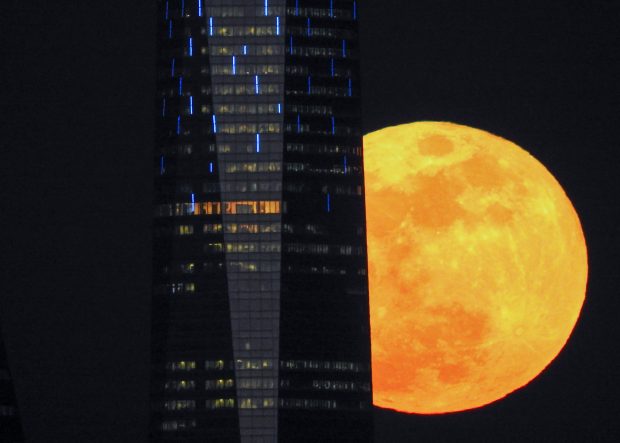
A full moon “supermoon” rises next to a skyscraper in Madrid, Spain, January 31, 2018. REUTERS/Paul Hanna
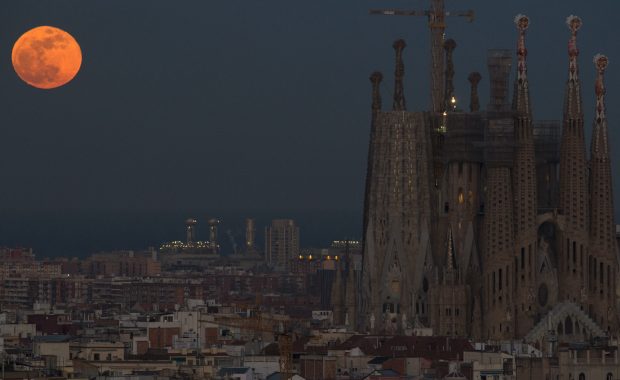
Barcelona’s Sagrada Familia Basilica is backdropped by a super blue blood moon in Barcelona, Spain, Wednesday, Jan. 31, 2018. On Wednesday, much of the world will get to see not only a blue moon which is a supermoon, but also a lunar eclipse, all rolled into one celestial phenomenon. (AP Photo/Manu Fernandez)
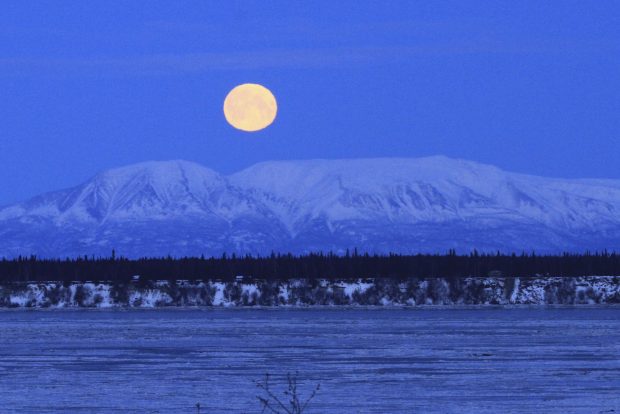
The moon sets over Mount Susitna, known locally as Sleeping Lady, across Cook Inlet on Wednesday, Jan. 31, in Anchorage, Alaska. (AP Photo/Dan Joling)
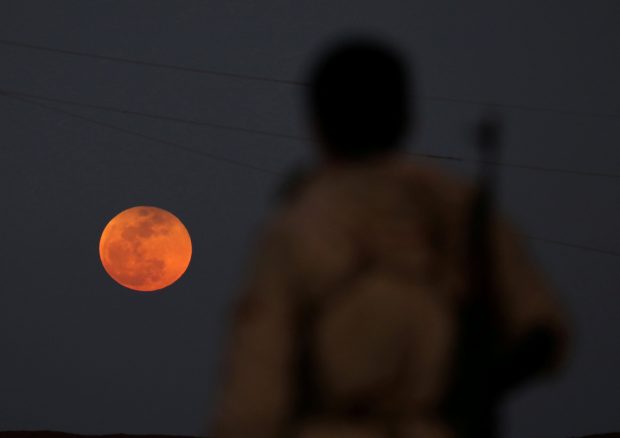
A fighter from Free Syrian Army is seen watching a full moon rises in Daraa, Syria January 31, 2018. REUTERS/ Alaa al-Faqir TPX IMAGES OF THE DAY
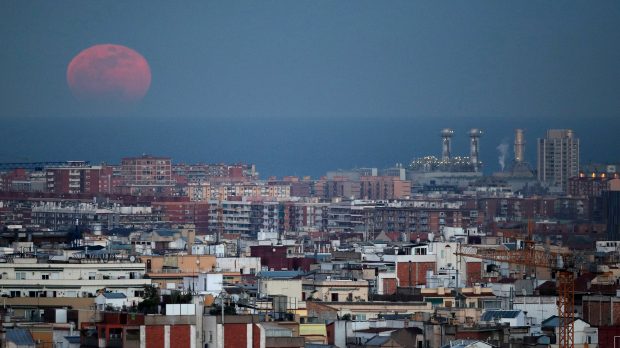
A full moon “Super Blue Blood Moon” rises behind Mediterranean sea in Barcelona, Spain January 31, 2018. REUTERS/Albert Gea
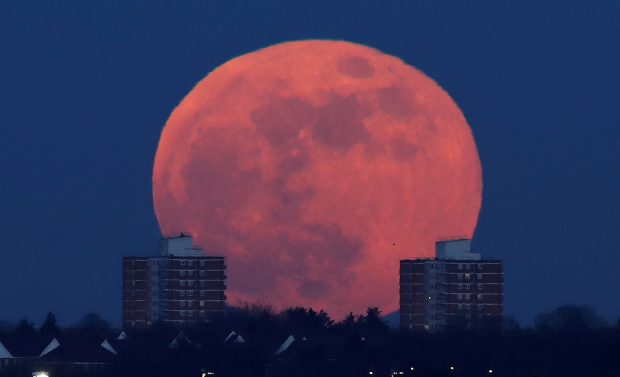
A full moon rises behind blocks of flats in north London, Britain, January 31, 2018. REUTERS/Eddie Keogh TPX IMAGES OF THE DAY
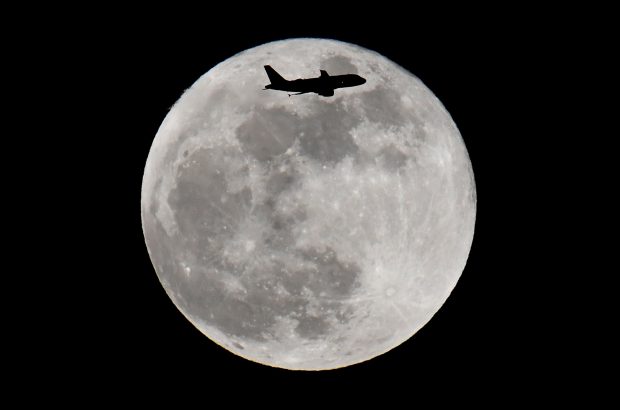
A passenger plane flies in front of a supermoon full moon over London, Britain, January 31, 2018. REUTERS/Toby Melville
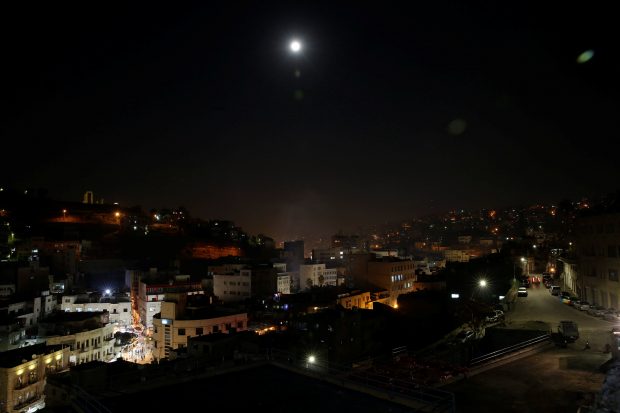
A super blue blood moon rise is seen in the sky of Jordanian capital Amman, January 31, 2018. REUTERS/Muhammad Hamed
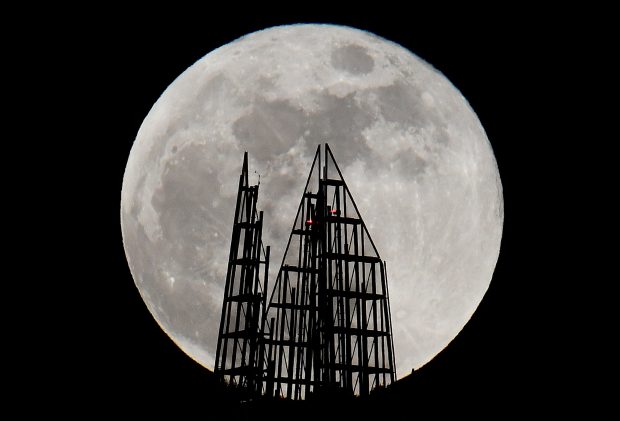
A supermoon full moon is seen behind the Shard skyscraper in London, Britain January 31, 2018. REUTERS/Toby Melville
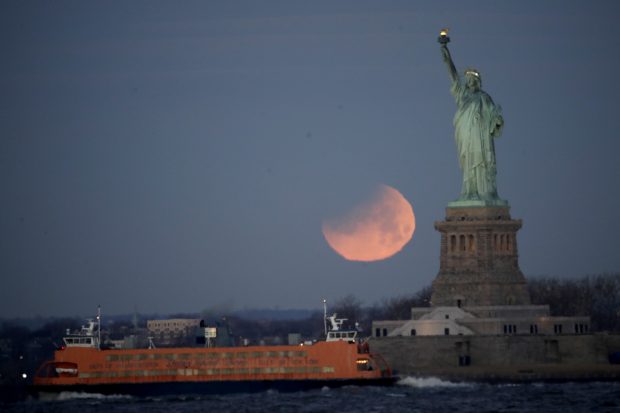
The Statue of Liberty and the Staten Island Ferry are backdropped by a supermoon, Wednesday, Jan. 31, 2018, seen from the Brooklyn borough of New York. The supermoon, which is the final of three consecutive supermoons, also experience lunar eclipse as it set over the horizon, but only a partial eclipse was visible in the East Coast. (AP Photo/Julio Cortez)
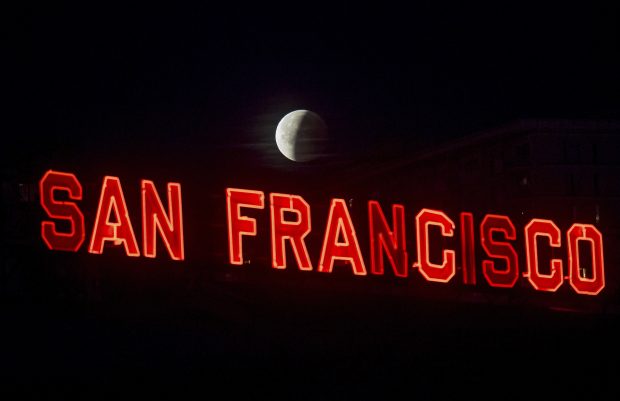
A partially-eclipsed super blue blood moon sets behind a sign at San Francisco’s Ferry Building on Wednesday, Jan. 31, 2018. It’s the first time in 35 years a blue moon has synced up with a supermoon and a total lunar eclipse, also called a blood moon because of its red hue. (AP Photo/Noah Berger)
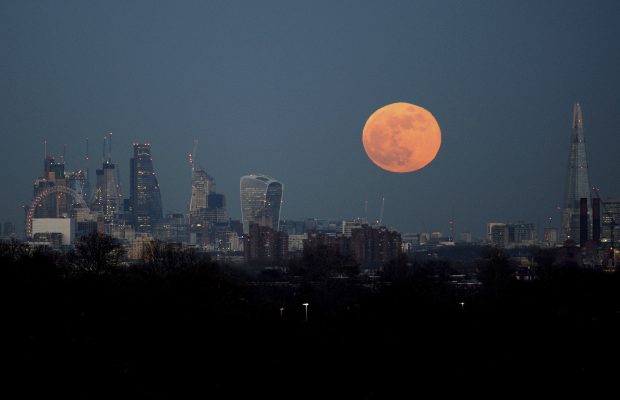
The moon rises over the London skyline, Wednesday Jan. 31, 2018. On Wednesday, much of the world will get to see not only a blue moon which is a supermoon, but also a lunar eclipse, all rolled into one celestial phenomenon. At left is the London Eye and at right The Shard. (KIrsty O’Connor/PA via AP)
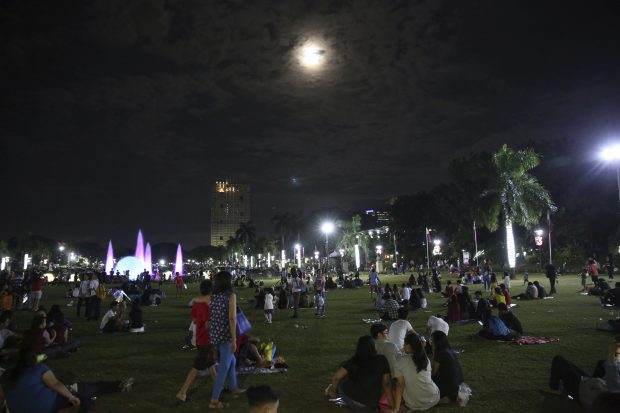
Filipinos watch a lunar eclipse at a park in Manila, Philippines on Wednesday, Jan. 31, 2018. On Wednesday, much of the world will get to see not only a blue moon which is a supermoon, but also a lunar eclipse, all rolled into one celestial phenomenon. (AP Photo/Aaron Favila)
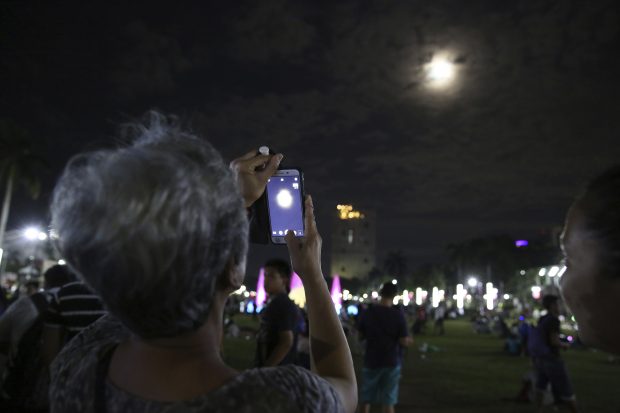
A woman records a lunar eclipse at a park in Manila, Philippines on Wednesday, Jan. 31, 2018. On Wednesday, much of the world will get to see not only a blue moon which is a supermoon, but also a lunar eclipse, all rolled into one celestial phenomenon. (AP Photo/Aaron Favila)
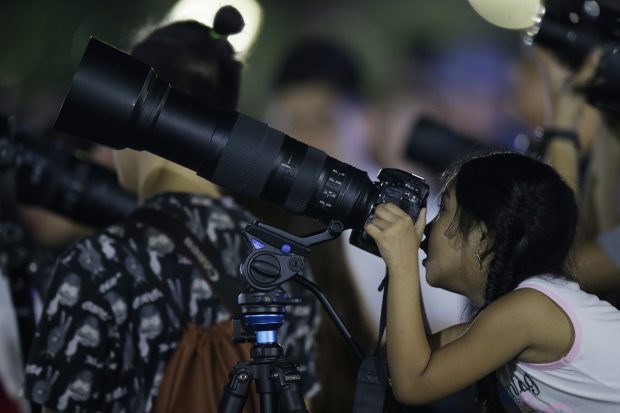
A girl peeks inside the viewfinder of a camera to see a lunar eclipse at a park in Manila, Philippines on Wednesday, Jan. 31, 2018. On Wednesday, much of the world will get to see not only a blue moon which is a supermoon, but also a lunar eclipse, all rolled into one celestial phenomenon. (AP Photo/Aaron Favila)

Silhouettes of people are seen looking out from the Shard skyscraper with a full moon “supermoon” seen behind in London, Britain January 31, 2018. REUTERS/Toby Melville
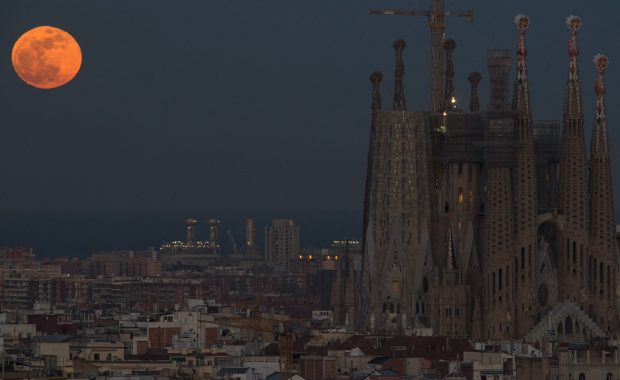
Barcelona’s Sagrada Familia Basilica is backdropped by a super blue blood moon in Barcelona, Spain, Wednesday, Jan. 31, 2018. On Wednesday, much of the world will get to see not only a blue moon which is a supermoon, but also a lunar eclipse, all rolled into one celestial phenomenon. (AP Photo/Manu Fernandez)
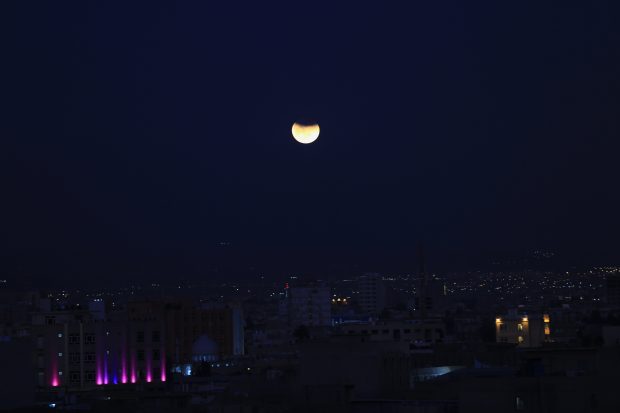
epa06488552 The supermoon passes out of the earth’s shadow during a lunar eclipse as a super blue blood moon sets over the downtown Erbil City, Kurdistan Region, Iraq, 31 January 2018. The previous ‘Supermoons’ appeared on 03 December 2017 and on 01 January 2018. A ‘Supermoon’ commonly is a full moon at its closest distance to the earth with the moon appearing larger than usual. EPA/GAILAN HAJI

epa06488550 A so-called ‘Supermoon’ rises above the Camlica Mosque in Istanbul, Turkey, 31 January 2018, during the last time in a series of three consecutive ‘Supermoons’, dubbed the ‘Supermoon Trilogy’. The previous ‘Supermoons’ appeared on 03 December 2017 and on 01 January 2018. A ‘Supermoon’ commonly is described as a full moon at its closest distance to the earth with the moon appearing larger and brighter than usual. EPA/SEDAT SUNA
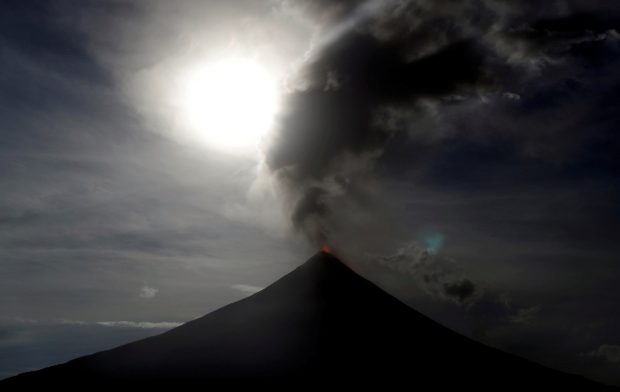
The super blue moon rises above the spewing Mayon Volcano during a mild eruption before a total lunar eclipse in Legazpi, Philippines, January 31, 2018. REUTERS/Erik De Castro TPX IMAGES OF THE DAY
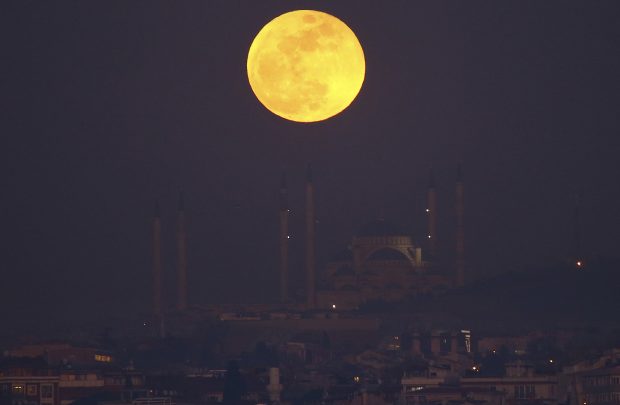
A super blue blood moon rises over Istanbul, behind the Camlica Mosque, the largest mosque in Asia Minor, Wednesday, Jan. 31, 2018. It’s the first time in 35 years a blue moon has synced up with a supermoon and a total lunar eclipse, or blood moon because of its red hue, all rolled into one celestial phenomenon. (AP Photo/Emrah Gurel)

With the Bosporus Strait separating Europe and Asia in the foreground, and the Camlica Mosque, top right, the largest mosque in Asia Minor, as the supermoon rises over Istanbul, Wednesday, Jan. 31, 2018. On Wednesday, much of the world will get to see not only a blue moon which is a supermoon, but also a lunar eclipse, turning the moon blood red, all rolled into one celestial phenomenon.(AP Photo/Emrah Gurel)
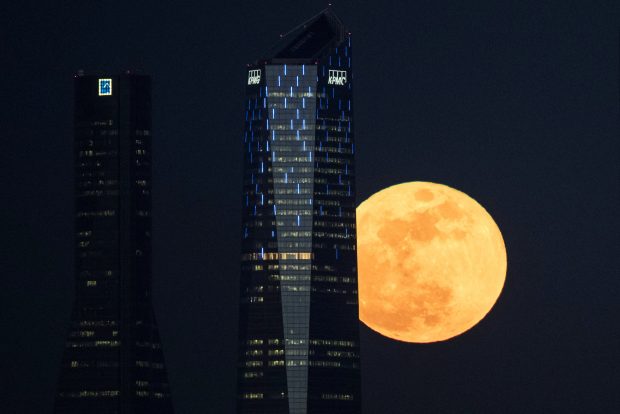
A full moon “supermoon” rises between skyscrapers in Madrid, Spain, January 31, 2018. REUTERS/Paul Hanna
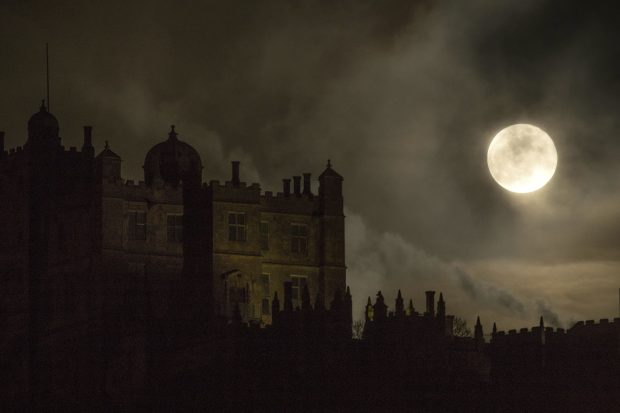
The moon rises over Bolsover Castle northwest England, Wednesday Jan. 31, 2018. On Wednesday, much of the world will get to see not only a blue moon which is a supermoon, but also a lunar eclipse, all rolled into one celestial phenomenon. Earth’s natural satellite appears about 14% bigger and 30% brighter in the sky as it reaches its closest point to Earth. (Aaron Chown/PA via AP)
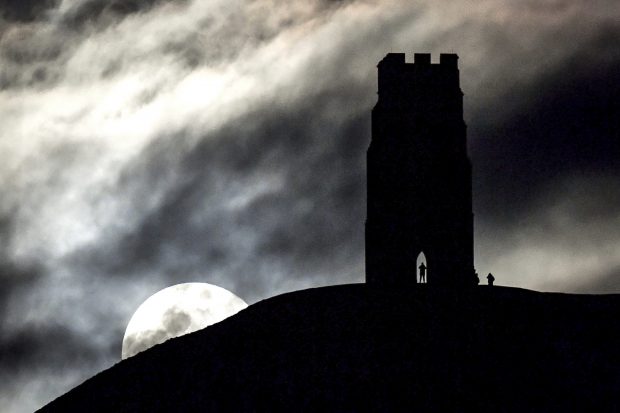
The moon rises behind Glastonbury Tor, southwestern England, Wednesday Jan. 31, 2018. On Wednesday, much of the world will get to see not only a blue moon which is a supermoon, but also a lunar eclipse, all rolled into one celestial phenomenon. (Ben Birchall/PA via AP)
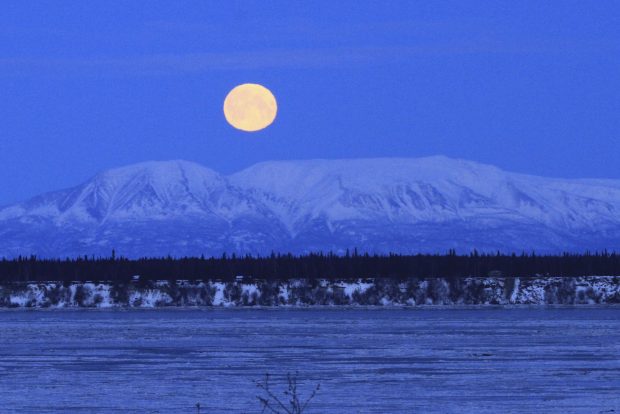
The moon sets over Mount Susitna, known locally as Sleeping Lady, across Cook Inlet on Wednesday, Jan. 31, in Anchorage, Alaska. (AP Photo/Dan Joling)
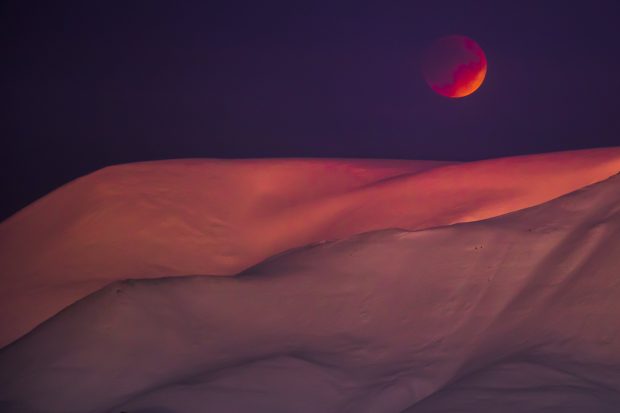
epa06488718 A super blue blood moon is seen from Longyearbyen, Svalbard, Norway, 31 January 2018, during the last time in a series of three consecutive ‘Supermoons’, dubbed the ‘Supermoon Trilogy’. The previous ‘Supermoons’ appeared on 03 December 2017 and on 01 January 2018. A ‘Supermoon’ commonly is described as a full moon at its closest distance to the earth with the moon appearing larger and brighter than usual. EPA/HEIKO JUNGE NORWAY OUT
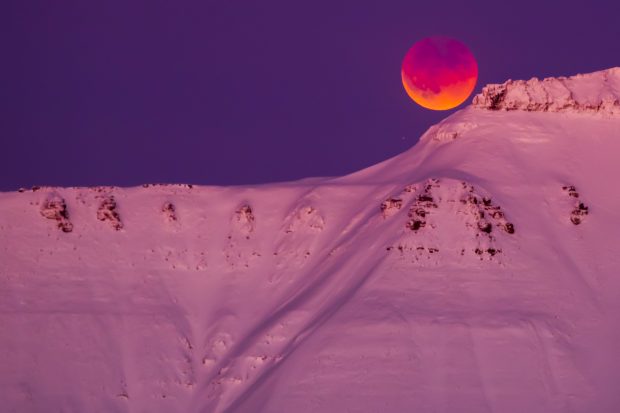
epa06488716 A super blue blood moon is seen from Longyearbyen, Svalbard, Norway, 31 January 2018, during the last time in a series of three consecutive ‘Supermoons’, dubbed the ‘Supermoon Trilogy’. The previous ‘Supermoons’ appeared on 03 December 2017 and on 01 January 2018. A ‘Supermoon’ commonly is described as a full moon at its closest distance to the earth with the moon appearing larger and brighter than usual. EPA/HEIKO JUNGE NORWAY OUT
Πηγή: kathimerini.gr

